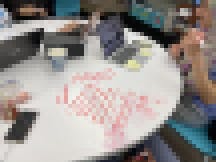The investigators erupt with excitement as the suspect appears, walking from his house to his car.
“There he is!”
“Right there!”
“Get him! Quick!”
The case: the 1932 Lindbergh kidnapping. The investigators: a group of students at Independence High School in Frisco, Texas. With their hard work, the man allegedly responsible for one of the most notorious crimes in U.S. history has been apprehended.
Students on a stakeout in the 1930s? Actually, it’s 2022, and they are sitting in Debbie Venteicher and Erin Stanley’s American Studies class, gathered around a device and collaboratively working to complete a digital breakout created with Genially. But based on the students’ reactions, they seem to have forgotten that they’re not on an actual investigation.
“Not only are students locked in and engaged, but conversations are buzzing around the room—students discussing various facts surrounding the case. However, what they rarely know is happening,” says Venteicher, “is that they are getting an immersion of 1930s pop culture. We’re able to have in-depth conversations about how the media and Hollywood played a role in the events.”

It has long been argued that learning through experience is the most effective way to master a subject. Studies show up to a 75 percent improvement in retention with experiential learning scenarios. The difficulty in bringing more of this type of learning into the classroom lies in the amount of time, effort and resources typically required.
How can the average teacher make this happen when creating a real-life experience is not possible or feasible? Many are putting together digital experiences with content-creation tools like Genially. Venteicher and Stanley embraced Genially for their Lindbergh project because it allowed them to create a professional-looking, engaging interactive experience for their students with minimal effort—no programming necessary!
7 Steps to a Genially Transformation
The Lindbergh lesson began as a straightforward article with discussion questions attached. Transforming it into a digital experiential activity took seven steps, which educators can follow when creating their own assignments:
1. Choose appropriate subject matter
Not all lessons translate well into experiential learning, but many can with a little creativity. Consider topics students struggle to retain, as well as those with a real-world application or connection. Venteicher and Stanley chose the Lindbergh case because of its scope, prominence and potential to turn it into an interactive investigation.
2. Identify lesson objectives
As with all effective lessons, teachers need to ask: What are the learning targets of the experience? What will the final assessment be, and how will the experience provide the necessary scaffolding for students to be successful?
3. Brainstorm story elements
The key to any immersive experience is the story. “Students can have fun with the plot, and it makes them connect with the material even more,” says Heather Brandon, a biology teacher at Independence who also uses Genially.
Here are some questions to consider:
- What is the setup for the content?
- Is it a breakout, an adventure or something else?
- How did the students end up in the scenario?
- What are they working toward?
With historical events such as the Lindbergh case, the story has already been written; it’s just a matter of determining where students fit in. For Venteicher and Stanley, it made sense for students to assume the role of lead investigators in the case.

4. Pick a template
Users can browse Genially’s ever-growing library, which includes free gamification templates, to find what best fits the content and story. It’s okay if a template doesn’t match perfectly because all of them can be customized and personalized. For example, “Detectives Breakout” was the starting point for Venteicher and Stanley’s Lindbergh investigation.
5. Consider placement of content and checks for understanding
Go through the template to determine where and how content and assessment can be delivered within the narrative. For the first part of the Lindbergh investigation, the Genially creation required students to examine details of the nursery crime scene (the content) in order to prepare for a series of questions asked by reporters at a press conference (the assessment). Another part tasked them with gathering information in order to type out a report for J. Edgar Hoover himself.
The immediate feedback provided by these periodic understanding checks is valuable.
“Students love that they know instantly if they are right or wrong, which allows them to ask questions about their mistakes,” says Brandon.
6. Incorporate game elements
Stories are good, but adding interactive game elements makes them great. Genially allowed Venteicher and Stanley to easily incorporate the following:
- Drag and drop
- Click animations
- Hidden items
- Soundtracks and sound effects
- Pages locked with secret codes
- Timed animations
7. Assign to students
Genially creations can be assigned to students in a variety of ways: via links, embedded in an LMS or web page or with a recently developed add-on that allows teachers to insert Genially creations directly into Google Classroom. With this feature, it’s no longer necessary to switch back and forth between platforms to add and share Genially content to assignments, classes and activities.
To learn how to use the new add-on, take a look at the quick and free Genially Academy course.
In a rapidly changing educational landscape with a focus on developing and nurturing future-ready learners, it is vital for educators to inject experiential learning into our classrooms whenever possible. Viewed through this lens, 21st-century digital tools become less of a novelty and more of a necessity. After all, there’s no substitute for experience—whether in the real world or the digital one.
Case closed.


/cdn.vox-cdn.com/uploads/chorus_image/image/62810996/Amm_DeepSentinel_01.0.jpg)

More Stories
Lookers Volkswagen Preston wins Motability Awards
Most small crossovers fail to protect rear passengers in new IIHS crash test
10 Best Christmas Vacations in the World